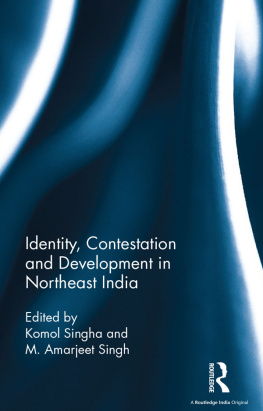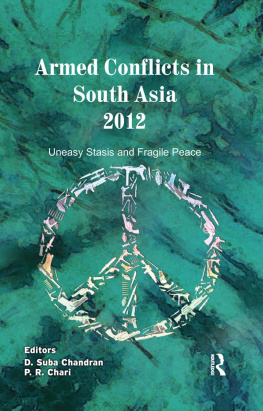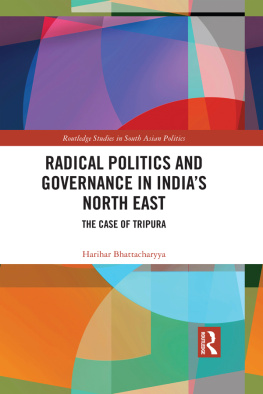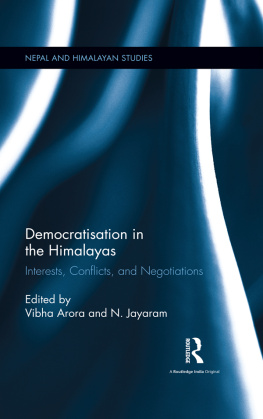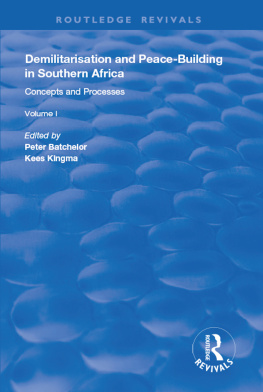Identity, Contestation and Development in Northeast India
Indias Northeast has long been riven by protracted armed conflicts for secession and movements for other forms of autonomy. This book shows how the conflicts in the region have gradually shifted towards inter-ethnic feuds, rendered more vicious by the ongoing multiplication of ethnicities in an already heterogeneous region. It further traces the intricate contours of the conflicts and the attempts of the dominant groups to establish their hegemonies against the consent of the smaller groups, as well as questions the efficacy of the states interventions. The volume also engages with the recurrent demands for political autonomy, and the resultant conundrum that hobbles the regions economic and political development processes.
Lucid, topical and thorough in analysis, this book will be useful to scholars and researchers in political science, sociology, development studies and peace and conflict studies, particularly those concerned with Northeast India.
Komol Singha is Associate Professor of Economics at Sikkim University, Gangtok, India, and holds a doctoral degree in development economics. His research areas are institutional economics, social capital, political economy, rural development and development issues related to Northeast India.
M. Amarjeet Singh is Associate Professor of Sociology at the Centre for North East Studies and Policy Research, Jamia Millia Islamia, New Delhi. His research and teaching focus on conflict studies, ethnicity, identity politics and migration studies.
The fourteen insightful chapters by scholars from anthropology, economics, history, philosophy, political science and sociology focus on a wide-ranging debate on ethnicity, identity, conflict and development of the north-eastern part of India. Students, scholars and policymakers dealing with Indias Northeast will find this book useful.
T. B. Subba, Professor and Vice Chancellor,
Sikkim University
The book engag[es] with some of the major socio-political issues in Northeast India. Ethnic identity narratives, territoriality and contestations, governance challenges, among others have been brought under one rubric for discussion. These essays would certainly generate further debates and help shape a better understanding of the region.
Bhagat Oinam, Professor,
Jawaharlal Nehru University
A refreshingly new take on the connection between insurgency and development by a group of young scholars beyond the otherwise clichd script of ethnicity and identity politics [A] must-read for those who think that understanding Indias Northeast has something to contribute to the larger social science repertoire.
Samir Kumar Das, Professor and
Dean of Arts, University of Calcutta
Identity, Contestation and Development in Northeast India
Edited by Komol Singha
and M. Amarjeet Singh
First published 2016
by Routledge
2 Park Square, Milton Park, Abingdon, Oxon OX14 4RN
and by Routledge
711 Third Avenue, New York, NY 10017
Routledge is an imprint of the Taylor & Francis Group, an informa business
2016 Komol Singha and M. Amarjeet Singh
The right of Komol Singha and M. Amarjeet Singh to be identified as the authors of the editorial material, and of the authors for their individual chapters, has been asserted in accordance with sections 77 and 78 of the Copyright, Designs and Patents Act 1988.
All rights reserved. No part of this book may be reprinted or reproduced or utilised in any form or by any electronic, mechanical, or other means, now known or hereafter invented, including photocopying and recording, or in any information storage or retrieval system, without permission in writing from the publishers.
Trademark notice: Product or corporate names may be trademarks or registered trademarks, and are used only for identification and explanation without intent to infringe.
British Library Cataloguing in Publication Data
A catalogue record for this book is available from the British Library
Library of Congress Cataloging-in-Publication Data
A catalog record has been requested for this book
ISBN: 978-1-138-95419-9 (hbk)
ISBN: 978-1-315-66703-4 (ebk)
Typeset in Galliard
by Apex CoVantage, LLC
Contents
Part I
Institution, resources and development
RAKHEE BHATTACHARYA
UDDIPANA GOSWAMI
J.J. ROY BURMAN
P.R. BHATTACHARJEE AND PURUSOTTAM NAYAK
KOMOL SINGHA AND M. AMARJEET SINGH
HOINEILHING SITLHOU
Part II
Ethnicity, identity and belonging
PURUSOTTAM NAYAK AND KOMOL SINGHA
LALRINTLUANGA
MOHAN DEBBARMA
SARIT KUMAR CHAUDHURI
KILANGLA B. JAMIR
TAJEN DABI
M. AMARJEET SINGH AND KOMOL SINGHA
L. MUHINDRO SINGH
Indias Northeastern Region consists of eight states and is a mixed bag of several ethnic groups. Around 200, out of 635 tribal groups of the country are found in this region. Geographically, the region covers an area of approximately 263,000 sq. km (8 per cent of the country), and its population is about 4.56 crore (3.77 per cent of the country) as per 2011 population census. Around three-fourths of the regions geographical area are covered by hilly terrain, and majority of the population (around 85 per cent) lives in villages, rural areas in poverty, in the midst of abundant resources. The region is connected with the mainland India by a small strip of land, around 20-km-wide chickens neck corridor at Siliguri in West Bengal. Physical infrastructure of the region is very poor compared to national level.
Despite its rich natural and human resources, the region is mired by a series of intractable conflicts. In the recent past, it has slowly shifted towards the inter-ethnic feuds and rendered more viciously by the ongoing amoebic multiplication of ethnicities in an already prodigiously heterogeneous region. Strident ethno-nationalistic assertions over the land and resources and articulation of grievances in terms of the others have given rise to contestations over the same space shared by multiple ethnic groups. Tacit assertions and explicit demands for hybrid identity-based exclusive homelands are accentuating the latent sociological fissures into apparent fault lines and often lead to ethnic cleansing and extermination of the smaller groups or politically weaker sections in the society. The intricate contours of the conflicts are getting convoluted with the attempts of the dominant groups to establish their hegemonies, and that are being challenged by the emerging subalterns sharing the same space. Propensity of the stakeholders to use violence as a political resource in pursuit of their objectives has fostered the ecology of violence resistant to restraint. States interventions to contain the non-state violence with rewards and incentives along the lines of ethnicities have compounded the situation further, accelerated the growth of newer identities or hybrid identities, and it often leads to recurrence of demand for autonomy within the region. The resultant conundrum hobbles the regions economic and political development processes in the long run.
Having understood this fact, many scholars working on the issue were invited to share their scholarly works, and finally fourteen essays have been chosen for this volume. The present volume entitled

